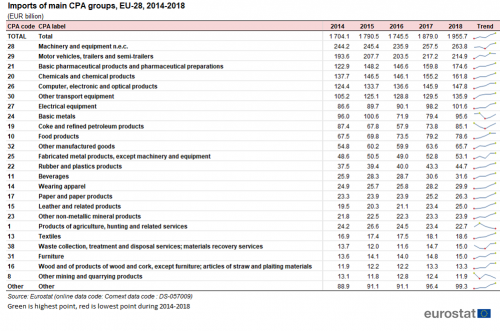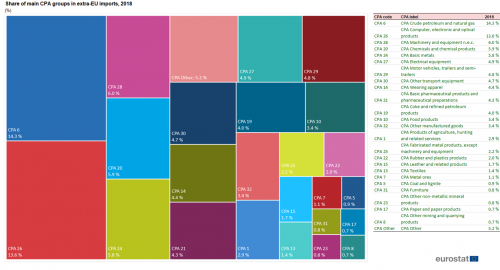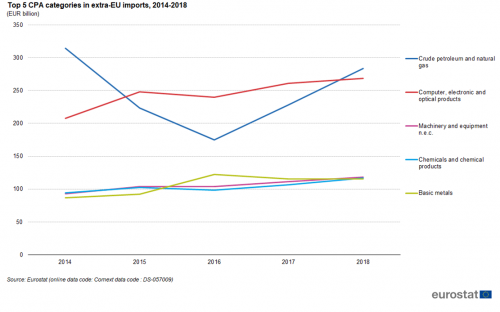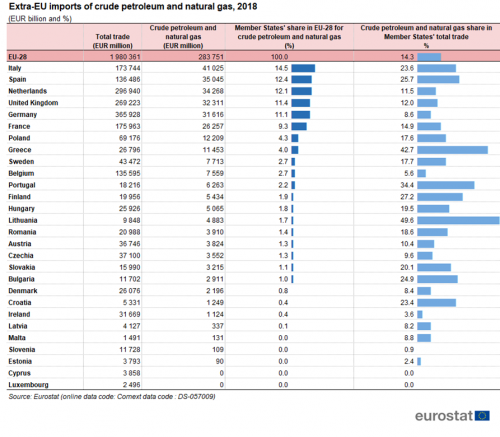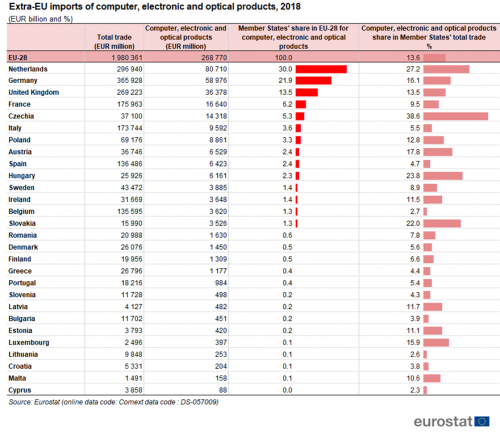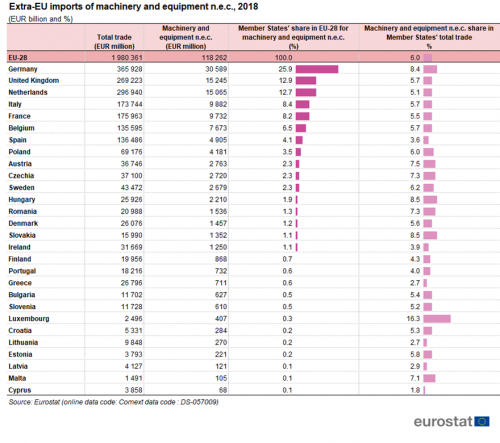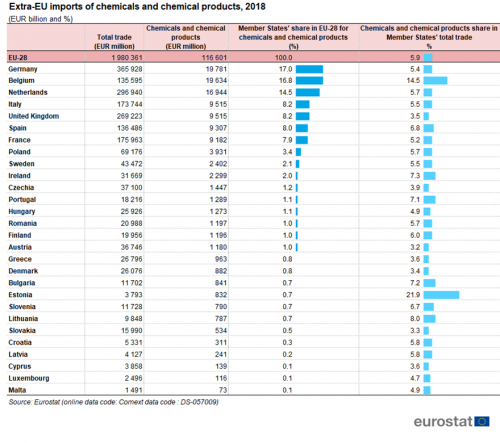Archive:Main goods in extra-EU imports
Data extracted in March 2019
Planned article update: April 2020
Highlights
Crude petroleum and natural gas and Computer, electronic and optical products were the most imported products by the EU every year between 2014 and 2018.
In 2018, the top 5 EU import products were crude petroleum and natural gas, computer, electronic and optical products (both 14 % of total imports) , basic metals, machinery and equipment and chemicals and chemical products (all three 6 %).
Shares for top 5 CPA categories in extra-EU imports, 2013-2017
This article focuses on the most significant goods by value (according to the CPA classification) in extra-EU imports. It presents statistics for the EU-28 from 2014 to 2018. Imported goods can be final goods but can also be important inputs for European industries. The article discusses the share of individual Member States in total extra-EU imports for the five most imported product groups. Additionally, it shows the share these product groups have in each Member States’ total extra-EU imports of goods.
The article is part of an online publication providing recent statistics on international trade in goods, covering information on the EU's main partners, main products traded, specific characteristics of trade as well as background information.
Full article
EU-28 imports by CPA groups
The CPA classification consists of 40 products. The 24 most imported products (with a value of more than EUR 10 billion in 2018) are shown in Table 1 while the other 16 are grouped as "Other". For 15 of the products the imports reached a high point in 2018. The most imported product, 'Crude petroleum and natural gas' was one of the exceptions.
The composition of total EU imports of goods in 2018 for the 24 CPA groups (Table1) is shown in Figure 1. The top two products 'Crude petroleum and natural gas' (oil & gas) with 14.3 % and 'Computer, electronic and optical products' (computers) with 13.6 % together account for over a quarter of all imports. Following at a distance, the next three products are 'Machinery and equipment n.e.c' (machines) with 6.0 %, 'Chemicals and chemical products' (chemicals) with 5.9 % and 'Basic metals' (metals) with 5.8 %. It is on these five product groups that the rest of the article will concentrate.
These 5 top product groups from 2018 were continuously in the top 5 from 2014 to 2018. Throughout the whole period, the same product groups occupied the top two places, namely computers and oil & gas, with the former overtaking the latter as the most imported product in 2015, in part due to falling prices for crude petroleum. However, in 2018 oil & gas became the most trade product once again. The other three products changed places throughout the period but always remained close to each other.
Crude petroleum and natural gas
Italy had a share of 14.5 % in extra-EU imports of oil & gas (see Figure 4). It was one of five countries with double-digit shares. The other four were Spain (12.4 %), the Netherlands (12.1 %), the United Kingdom (11.4 %) and Germany (11.1 %). For nine Member States, oil & gas made up more than one fifth of their total imports of goods from outside the EU. These were Lithuania (49.6 %), Greece (42.7 %), Portugal (34.4 %) , Finland (27.2 %) , Spain (25.7 %), Bulgaria (24.9 %), Italy (23.6 %), Croatia (23.4 %) and Slovakia (20.1). Shares below 5 % were recorded in Ireland (3.6 %), Estonia (2.4 %) and Slovenia (0.9 %). Cyprus and Luxembourg did not import oil & gas at all. For the whole EU the share was 14.3 %.
Computer, electronic and optical products
The Netherlands was responsible for 30.0 % of EU imports of computers, followed at some distance by Germany (21.9 %) and the United Kingdom (13.5 %) (see Figure 3). For the Netherlands, these imports made up 27.2 % of all goods imported from outside the EU. Only Czechia (38.6 %) had a higher share while in Hungary (23.8 %) and Slovakia (22.0 %) the shares were also above 20 %. Eight countries had shares below 5 %. These were Spain (4.7%), Greece (4.4 %), Slovenia (4.3 %), Bulgaria (3.9 %), Croatia (3.8 %), Belgium (2.7 %), Lithuania (2.6 %) and Cyprus (2.3 %). For the EU as whole the share was 13.6 %.
Other machinery and equipment
Over a quarter of all extra-EU imports of machines was imported by Germany (25.9 %) (see Figure 5) . This was about as much as the next two countries, the United Kingdom (12.9 %) and the Netherlands (12.7 %) combined. Only in Luxembourg (16.3 %) imports of this product group made up more than 10 % of their total imports of goods from outside the EU. Shares below 3% were recorded in Latvia (2.9 %), Lithuania, Greece (both 2.7 %) and Cyprus (1.8 %). The share for the whole EU was 6.0 %.
Chemicals and chemical products
The top three importers in the EU accounted for alomst half of the EU's total imports of chemicals (see Figure 6). These were Germany (17.0 %), Belgium (16.8 %) and the Netherlands (14.5 %). For Belgium this meant that imports of chemicals made up 14.5 % of their total imports of goods from outside the EU. Estonia (21.9 %) was the only other country where this share was above 10 %. The share was below 4 % in Czechia (3.9 %), Cyprus, Greece (both 3.6 %), the United Kingdom (3.5 %), Denmark (3.4 %), Slovakia (3.3 %), and Austria (3.2 %). For the whole EU the share was 5.9 %.
Imports of basic metals
Over a quarter of extra-EU imports of metals was imported by the United Kingdom (25.6 %) (see Figure 7). Shares above 10 % were also found in Italy (15.5 %), the Netherlands (13.0 %) and Germany (12.2 %). Four countries had double-digit shares for metals in their total imports of goods from outside the EU. These were Bulgaria (11.6 %), the United Kingdom (11.0 %), Latvia (10.5 %) and Italy (10.3 %). Shares below 2% were recorded only in Luxembourg, Malta (both 1.7 %), Ireland (1.3 %) and Cyprus (1.1 %). The share for the whole EU was 5.8 %.
Source data for tables and graphs
Data sources
EU data is taken from Eurostat's COMEXT database. COMEXT is the reference database for international trade in goods. It provides access not only to both recent and historical data from the EU Member States but also to statistics of a significant number of third countries. International trade aggregated and detailed statistics disseminated via the Eurostat website are compiled from COMEXT data according to a monthly process.
Data are collected by the competent national authorities of the Member States and compiled according to a harmonised methodology established by EU regulations before transmission to Eurostat. For extra-EU trade, the statistical information is mainly provided by the traders on the basis of customs declarations.
EU data are compiled according to Community guidelines and may, therefore, differ from national data published by the Member States. Statistics on extra-EU trade are calculated as the sum of trade of each of the 28 EU Member States with countries outside the EU. In other words, the EU is considered as a single trading entity and trade flows are measured into and out of the area, but not within it.
Methodology
According to the EU concepts and definitions, extra-EU trade statistics (trade between EU Member States and non-EU countries) do not record exchanges involving goods in transit, placed in a customs warehouse or given temporary admission (for trade fairs, temporary exhibitions, tests, etc.). This is known as ‘special trade’. The partner is the country of final destination of the goods for imports and the country of origin for imports.
Product classification
Classification of products by activity (CPA) is a statistical classification of products and services obligatory for all EU Member States. CPA classifies products by activity in which they are produced. Products are transportable goods and services. The CPA is a product classification whose elements are related to activities as defined by NACE Rev. 2. Each product - whether it be a transportable or a non-transportable good or a service - is assigned to one single NACE Rev. 2 activity. The linkage to activities as defined by NACE Rev. 2 gives the CPA a structure parallel to that of NACE Rev. 2 at all levels distinguished by NACE Rev. 2.
Unit of measure
Trade values are expressed in millions or billions (109) of euros. They correspond to the statistical value, i.e. to the amount which would be invoiced in the event of sale or purchase at the national border of the reporting country. It is called a FOB value (free on board) for imports and a CIF value (cost, insurance, freight) for imports.
Context
Trade is an important indicator of Europe’s prosperity and place in the world. The bloc is deeply integrated into global markets both for the products it sources and the imports it sells. The EU trade policy is an important element of the external dimension of the ‘Europe 2020 strategy for smart, sustainable and inclusive growth’ and is one of the main pillars of the EU’s relations with the rest of the world.
Because the 28 EU Member States share a single market and a single external border, they also have a single trade policy. EU Member States speak and negotiate collectively, both in the World Trade Organization, where the rules of international trade are agreed and enforced, and with individual trading partners. This common policy enables them to speak with one voice in trade negotiations, maximising their impact in such negotiations. This is even more important in a globalised world in which economies tend to cluster together in regional groups.
The openness of the EU’s trade regime has meant that the EU is the biggest player on the global trading scene and remains a good region to do business with. Thanks to the ease of modern transport and communications, it is now easier to produce, buy and sell goods around the world which gives European companies of every size the potential to trade outside Europe.
Direct access to
- International trade in goods - long-term indicators (t_ext_go_lti)
- International trade of machinery and transport equipment (SITC 7), by declaring country (tet00009)
- Extra-EU28 trade of machinery and transport equipment (SITC 7), by Member State (tet00059)
- Extra-EU28 trade of machinery and transport equipment (SITC 7), by main partners (tet00030)
- International trade in goods - short-term indicators (t_ext_go_sti)
- Imports of goods - machinery and transport equipment (teiet170)
- imports of goods - machinery and transport equipment (teiet070)
- International trade in goods - aggregated data (ext_go_agg)
- International trade in goods - detailed data (detail)
- International trade in goods statistics - background
- International trade in goods (ESMS metadata file — ext_go_esms)
- User guide on European statistics on international trade in goods
- Regulation (EC) No 471/2009 of 6 May 2009 on Community statistics relating to external trade with non-member countries
- Regulation (EU) No 92/2010 of 2 February 2010 implementing Regulation (EC) No 471/2009, as regards data exchange between customs authorities and national statistical authorities, compilation of statistics and quality assessment
- Regulation (EU) No 113/2010 of 9 February 2010 implementing Regulation (EC) No 471/2009 , as regards trade coverage, definition of the data, compilation of statistics on trade by business characteristics and by invoicing currency, and specific goods or movements.
